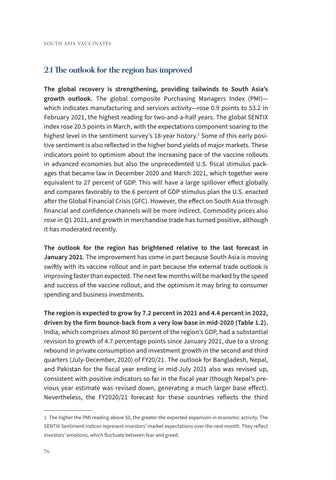S O U T H A S I A VA C C I N A T E S
2.1 The outlook for the region has improved The global recovery is strengthening, providing tailwinds to South Asia’s growth outlook. The global composite Purchasing Managers Index (PMI)— which indicates manufacturing and services activity—rose 0.9 points to 53.2 in February 2021, the highest reading for two-and-a-half years. The global SENTIX index rose 20.5 points in March, with the expectations component soaring to the highest level in the sentiment survey’s 18-year history.1 Some of this early positive sentiment is also reflected in the higher bond yields of major markets. These indicators point to optimism about the increasing pace of the vaccine rollouts in advanced economies but also the unprecedented U.S. fiscal stimulus packages that became law in December 2020 and March 2021, which together were equivalent to 27 percent of GDP. This will have a large spillover effect globally and compares favorably to the 6 percent of GDP stimulus plan the U.S. enacted after the Global Financial Crisis (GFC). However, the effect on South Asia through financial and confidence channels will be more indirect. Commodity prices also rose in Q1 2021, and growth in merchandise trade has turned positive, although it has moderated recently. The outlook for the region has brightened relative to the last forecast in January 2021. The improvement has come in part because South Asia is moving swiftly with its vaccine rollout and in part because the external trade outlook is improving faster than expected. The next few months will be marked by the speed and success of the vaccine rollout, and the optimism it may bring to consumer spending and business investments. The region is expected to grow by 7.2 percent in 2021 and 4.4 percent in 2022, driven by the firm bounce-back from a very low base in mid-2020 (Table 1.2). India, which comprises almost 80 percent of the region’s GDP, had a substantial revision to growth of 4.7 percentage points since January 2021, due to a strong rebound in private consumption and investment growth in the second and third quarters (July-December, 2020) of FY20/21. The outlook for Bangladesh, Nepal, and Pakistan for the fiscal year ending in mid-July 2021 also was revised up, consistent with positive indicators so far in the fiscal year (though Nepal’s previous year estimate was revised down, generating a much larger base effect). Nevertheless, the FY2020/21 forecast for these countries reflects the third 1 The higher the PMI reading above 50, the greater the expected expansion in economic activity. The SENTIX Sentiment Indices represent investors' market expectations over the next month. They reflect investors' emotions, which fluctuate between fear and greed. 76




